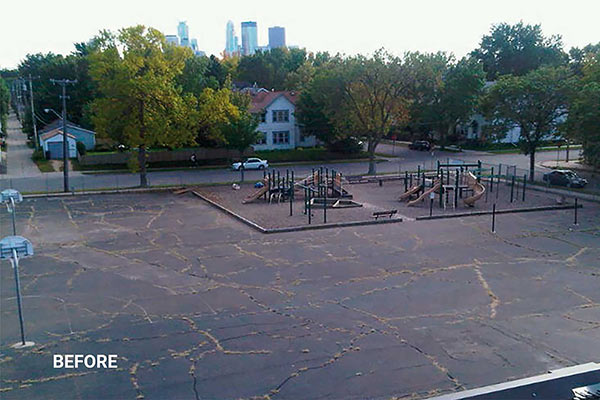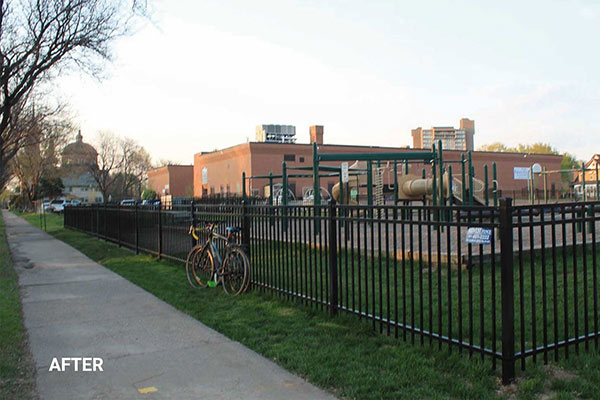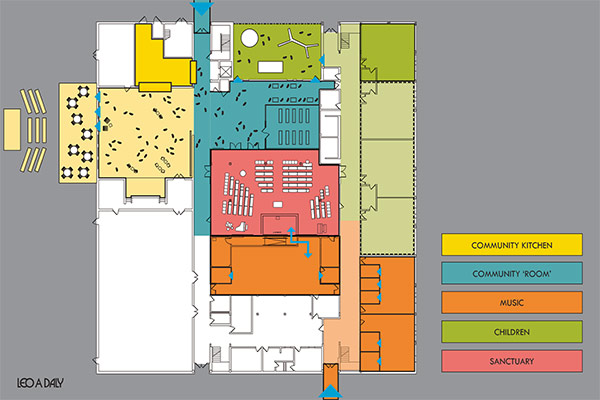Recent Articles
Grace Center and its community feed the soul of neighborhood
by Cindy McCleary, AIA, NCARB, LEED AP
Managing principal, Minneapolis
As an architect, I see first-hand the impact that great design can have on our collective environment. Many times, the most fulfilling and impactful design projects are not the big, glassy ones, but those that are rich in meaning and feed the soul. An example that is particularly close to my heart is the Grace Center for Community Life.
A shuttered public school building sat tired, vacant and lifeless in the middle of a northeast Minneapolis neighborhood. The parking lot was a barren wasteland of asphalt – lonely in the winter, blazing hot in the summer. But one community saw something in that old tired property.
The enormous building was boarded up, surrounded by high chain-link fencing and asphalt. Imagine the impact such a void would have on the neighborhood.
From Shuttered to Life-Giving
But in 2010, Grace Center was established as a community center focused on faith, learning and service. Its intent was to provide a home for the steward, Grace Lutheran Church, but the vision was to return the building to life, support life-giving activities for the community and fill the building and the land with opportunities to fill the soul of the community.
Today, Grace Center is home to several organizations that are not necessarily affiliated with Grace Lutheran Church: a Montessori school (ages 3 to 6), two public charter schools, gymnasium for community sports teams, a community kitchen and the Little Kitchen Food Shelf. However, the individual organizations are not the story that really feeds my soul. It is what brought them together that is so impactful and what has subsequently happened through that collaboration.
Grace Center’s long-term vision includes enhancing the arts and recreational opportunities in the neighborhood and bringing new services to the community. This vision also includes improving the aesthetics, safety and sustainability of the property. Our team at LEO A DALY helped kick-start this vision by developing a master plan for the facility, putting design ideas to the vision and returning life to the 2.86-acre site.
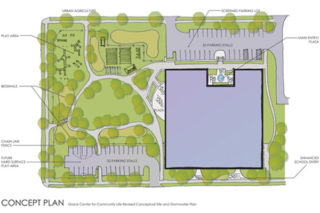 This master planning process provided the opportunity for Grace Center to plan its spaces for multiple purposes. This flexibility and multi-use approach is foundational to the building and the site. Key among the building and site improvements are the renovation of the commercial kitchen and community room spaces, as well as significant site improvements that welcome the community.
This master planning process provided the opportunity for Grace Center to plan its spaces for multiple purposes. This flexibility and multi-use approach is foundational to the building and the site. Key among the building and site improvements are the renovation of the commercial kitchen and community room spaces, as well as significant site improvements that welcome the community.
Feed the Community, Feed the Soul
Though each Grace Center occupant has separate missions, the common vision of the Center is to leverage their adjacencies to enhance life; provide richness of opportunities through recreation, art, music, nurturing, education, dining, fellowship and spiritual seeking; and to enhance and fulfill the lives of members of the community.
One aspect of the Grace Center that is near and dear to my heart is its “plant, grow, teach and feed” philosophy. The group wanted to connect to the outdoors and give the asphalt wasteland a role to play in the cycle.
The master plan laid out a series of renovations to occur over time. The food shelf first; then kitchen; connector for the kitchen and food shelf; development of an adjacent fellowship hall, including doors and a large glass opening from the public corridor and center of the building/sanctuary; and an opening from the fellowship hall to the outdoors for access to vegetable gardens, playground and flower gardens.
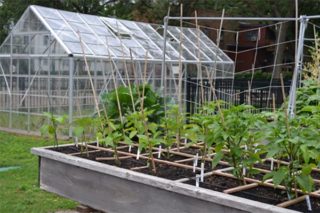 This new access point allows the natural connection between fellowship activities and the environment to thrive. It is also the foundation for new vegetable gardens tended by volunteers, which feed the food shelf.
This new access point allows the natural connection between fellowship activities and the environment to thrive. It is also the foundation for new vegetable gardens tended by volunteers, which feed the food shelf.
The onsite Grace Gardens project started in 2011, with two 4’x8’ raised beds. Today, the garden provides more than 500 pounds of vegetables and herbs each season.
The philosophies, “feed the soul” and “teach a man to fish,” played out in real time.
Making the food available is only half the battle – as any gardener knows, seasonal produce is not always well-known to the home cook. To ensure that clients of the food shelf can use this produce, Little Kitchen Food Shelf takes advantage of its location adjacent to the commercial kitchen to host cooking classes. This full-circle approach integrates the land, the people and the building to help increase food security throughout the community.
Water Ecology and An Open Invitation
But there was a missing element. A connection to the earth from which it all came; from which it can be replenished to continue the circle. For me, that’s where the impact of architecture and environment come into play.
Growing produce onsite and supplying the food shelf was only one piece of the puzzle. Applying the ideas of “renew, nurture, teach and replenish” further into the landscape meant improving the multiple-acre site that surrounds Grace Center.
First, the high fencing and large expanse of asphalt were hardly welcoming to the community. Second, the 30,000-SF roof on the building and the hard surfaces on the site did little to improve the ecology, provide a respite within the urban neighborhood or capture the excess stormwater that ran over its surface. Something had to be done.
Energy flows in all directions around this community center. Its impact on the neighborhood and the environment are significantly improved. This is a project I will carry with me, as it explains why I do what I do. It’s a powerful example of what a strong vision and design thinking can accomplish; an ecology that supports renewal, nurture, teaching and feeding the soul.
Grace Center isn’t finished yet either – it will put the finishing touches on its new accessible playground this summer. I can’t wait to see what Grace Center does next!
 About the author
About the author

